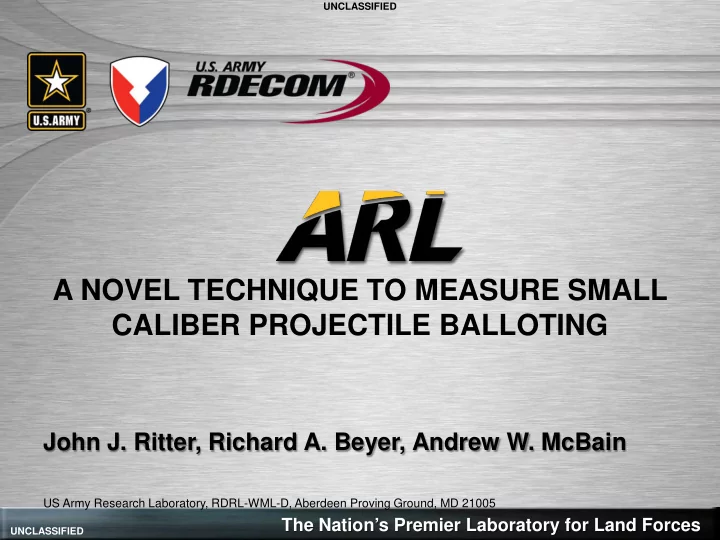

UNCLASSIFIED UNCLASSIFIED A NOVEL TECHNIQUE TO MEASURE SMALL CALIBER PROJECTILE BALLOTING John J. Ritter, Richard A. Beyer, Andrew W. McBain US Army Research Laboratory, RDRL-WML-D, Aberdeen Proving Ground, MD 21005 The Nation’s Premier Laboratory for Land Forces The Nation’s Premier Laboratory for Land Forces UNCLASSIFIED UNCLASSIFIED
UNCLASSIFIED Balloting • Dynamic misalignment of the projectile within the barrel of a gun • In-bore yaw is the static misalignment of the projectile • i.e. the offset angle stays constant and rotates with the rifling • Symptoms of balloting include • Increases in dispersion immediately from muzzle exit • Increased gun tube wear 5.56mm Short Gun McCoy, R.L. “Modern Exterior Ballistics Second Edition,” Atglen, PA. Schiffer. 2012 The Nation’s Premier Laboratory for Land Forces UNCLASSIFIED
UNCLASSIFIED Explanations • Balloting can occur because of the projectile entering the bore misaligned • Run out in the case neck • Non-axisymmetric projectiles • Unsupported leade distance • Also occur when the center of mass is not in concentricity with the projectile and the bore (Right) Calculated x and y displacement of the center of the bourrelet of 3 different 155mm projectiles with a CG imbalance in a worn tube 1 McCoy, R.L. “Modern Exterior Ballistics Second Edition,” Atglen, PA. Schiffer. 2012 1 Chu, S.H., “In-Bore Motion Analysis of 155mm Projectiles M107, M483A1, and M549 in M198 Gun,” ARLCD-TR-80048, Large Caliber Weapon Systems Laboratory, Dover, NJ; October 1981 The Nation’s Premier Laboratory for Land Forces UNCLASSIFIED
UNCLASSIFIED Large Caliber Techniques • Analytical • Need for experimental data to inform modeling • Optical Lever • Significant blow-by decreases signal • In-bore Radar • Provides verification of balloting • Lacks detailed information • On-board diagnostics • Small projectile size • High acceleration • Extremely harsh environment 1 Haug, B.T., “Microwave Radar Techniques Applied to Gun Accuracy In-bore Radar technique showing Measurements,” BRL-MR-3581, Ballistics Research Laboratory, Aberdeen Proving balloting in a 37mm system 1 Ground, Maryland; April 1987 The Nation’s Premier Laboratory for Land Forces UNCLASSIFIED
UNCLASSIFIED Small Caliber Observations • Short gun experiments had noticeable off axis projectile movement • (Shown previously) • Added a ‘flag’ to projectile for use in normal barrels 9mm, 5-in gun, 1:10 twist, 0.100” diameter carbon rod with flag • Flag and rod could be impacting the dynamics • Rod noticeably bending and splitting after exiting the barrel The Nation’s Premier Laboratory for Land Forces UNCLASSIFIED
UNCLASSIFIED Engraving Marks • Grooves made on the projectile from the gun tube rifling • Represent the entirety of balloting motion during launch • Projectiles were caught using several feet of foam blocks • Expectation: • Grooves mismatched fore and aft (location) • Variable groove length • Groove depth differences Projectile at 5° off axis (exaggeration). Note the different length markings and relative location The Nation’s Premier Laboratory for Land Forces UNCLASSIFIED
UNCLASSIFIED Engraving Marks (cont.) 2 1 • Recovered 7.62mm 1) Grooves mismatched location 2) Groove depth differences The Nation’s Premier Laboratory for Land Forces UNCLASSIFIED
UNCLASSIFIED Engraving Marks (cont.) • Groove angle also explored • Difficult to make precise surface measurements due to cylindrical surface and no depth information Twist Angle = tan -1 ( π d/n) • • Where d is the projectile diameter and n is the twist rate (1 in n) The Nation’s Premier Laboratory for Land Forces UNCLASSIFIED
UNCLASSIFIED Engraving Marks (cont.) • Engraving marks on M80, 7.62mm, projectiles detailed in Table 1 • Very similar engraving angles around the projectile on both sides of the groove • Engraved grooves approximately at the twist angle expected Table 1. Angle measurements of grooves cut into projectiles. 10-Inch Barrel Angles (degrees) Groove Leading Trailing Leading Trailing 1 5.36 5.23 0.12 0.17 2 5.38 5.21 0.15 0.22 3 5.43 5.13 0.21 0.07 7.62mm with 1 in 10 twist 4 5.42 5.22 0.11 0.19 Averages SD 5.38° 5-Inch Barrel Angles (degrees) Groove Leading Trailing Leading Trailing 1 5.23 5.05 0.12 0.08 2 5.30 5.10 0.27 0.46 3 5.43 4.91 0.09 0.31 4 5.21 5.05 0.09 0.15 Averages SD The Nation’s Premier Laboratory for Land Forces UNCLASSIFIED
UNCLASSIFIED Verification • Devise methods to induce exaggerated balloting and to validate the measurement process • Asymmetric CG projectile with base designed to promote non-axial engraving • Misaligned breech • Bent barrel to promote balloting Chamfered 7.62mm with non axial CG 7.62mm Fired from barrel with 0.065” chamber offset The Nation’s Premier Laboratory for Land Forces UNCLASSIFIED
UNCLASSIFIED Current Work • Exploring different options for measuring the engraving marks • CT scan of the projectile and mapping the surface • Blue light laser scanning • These give more precise measurement of the location and depth of the engravings Reconstruction of surface from CT scans Laser Scan The Nation’s Premier Laboratory for Land Forces UNCLASSIFIED
UNCLASSIFIED Current Work (cont.) • 9mm CT scan surface maps • Variation in engraving angle and location fore-aft Pre-ECP M9 Barrel Axial Position from Tip (mm) Post-ECP M9 Barrel Radius (um) Post-ECP Mann Barrel Angle about Projectile (degrees) The Nation’s Premier Laboratory for Land Forces UNCLASSIFIED
UNCLASSIFIED Acknowledgements • Joe Colburn for in-bore radar measurements • Tony Canami for setup and assisting in the experiments • Ryan Gilley and Scott Grendahl for information on laser scanning • Chris Peitsch and James Garner for information on CT scanning The Nation’s Premier Laboratory for Land Forces UNCLASSIFIED
Recommend
More recommend